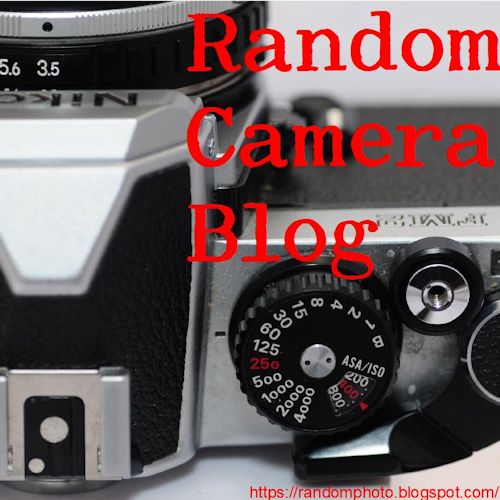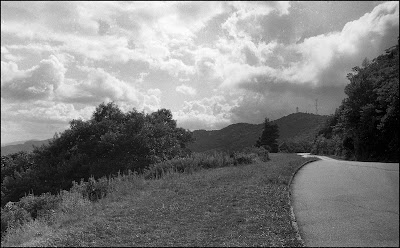 |
| My Nikon Df and a 50 yr old Nikkor lens. Bridging two worlds. |
In 2004, blogging was becoming popular, and it seems like a lot of people were starting blogs to share their interests. Mind you, this was before social media and smartphones took over. It was also the start of Flickr, the long-time photo sharing site that I still use, 20 years later. It’s as much of an archive of my work as anything, and I am still happy with it. When I started Random Camera Blog, I was four years into my deep dive into photography, and have not wavered from that at all. Initially, I saw RCB as a way to share a few images and share my use of different cameras and films. My first post was on October 14, 2004, and 883 posts later, here I am.

Twenty years on the Internet IS a long time. A lot of things have happened in the photography world since 2004, one being the domination of the digital camera, which also led to the disappearance of new film cameras, the loss of many film stocks, the takeover by DSLRs among photographers, the rise of new and unexpected technologies -- such as the Apple iPhone, which caused a huge paradigm shift in how we interact and use photography. The rise of the micro 4/3 and mirrorless system cameras, which were at one time considered just an offshoot, are now a mainstream part of photography. Despite all these technological advances, one thing has been a bit of a surprise -- the rebirth of film photography. Some might say it never went away, and of course, it didn’t, but now we are seeing a younger generation interested in using film cameras, and discovering the creative possibilities that film and other alternative processes can offer. I should also add that digital photography has allowed millions of people to explore photography without the burden of dealing with chemicals, labs, and gatekeepers. Many of them have never used film cameras, and some are now discovering that they are a whole new world.
 |
| My 10 year association with Mike Raso and The FPP has been a hell of a lot of fun |
I am someone that has shot with film since I first had a camera in the early 1970s. I lived in a rural part of upstate New York and did not know anything about the history of photography, nor much about the photographic world. In 1973, I took my only class in photography, which was an after-school activity sponsored by my high school science teacher. I vividly remember the magic of cracking open the b&w Verichrome Pan 126 cartridge that I had used in my Kodak Instamatic, transferring to a developing reel and tank, and seeing my very first self-developed roll of film. You know what? I still feel the magic of doing that to this day. I think that if I had a mentor at the time, it’s quite possible that I would have chosen photography as a vocation, but I didn’t even know that you could make money being a photographer. In 1974, I received an Exa Ia SLR for Christmas, with a Kodak pocket photography guide as my only resource. As clunky and limited as that camera was, I did learn how to photograph on my own.
 |
| My first SLR. |
Fast forward to the year 1999, and with the influence of a promised new world of digital imaging, I realized that my Apple QuickTake 200 just wasn’t getting the job done taking photos of insects. At 640x480 pixels, it was only good for making images for the web, but not much more than that. I had attended a presentation later that year, and saw how wonderful the presenter’s slides were of insect macrophotography using slide film, of course. That sparked my interest in using my Pentax ME to do similar things, and in 2000, I really started to delve into macrophotography. The books by John Shaw were really useful, and also steered me towards the Nikon system. I also had a mentor -- William Brudon, who was tickled to share his knowledge, books, cameras and film with me. Bill was a well-regarded medical illustrator, painter, and very much a photography expert. It was his influence that turned me into a well-rounded photographer, and the only way I can repay him is to try and do the same for others. Bill passed away in 2009, and I still have a lot of the books that he provided to me, as well as some cameras such as my Nikon F3HP that I use regularly.
 |
| By 2001, my kit was all-Nikon (Apple QT 200 photo) |
Random Camera Blog arose from wanting to not just share my enthusiasm for photography, but also to educate others about cameras, the photographic process, and of course, the various film stocks. When I think about how cheap expired film was into the early 2000s compared to now, it’s a bit sobering. I could go into a local camera store (at one time, there were at least 4 camera stores in Ann Arbor, MI) and buy rolls of recently expired film for a buck a roll! Throughout the years, RCB has endured the demise of camera stores, the loss of cheap developing at a local lab, the sell-off of used film cameras for pennies on the dollar, and then the emergence of Lomography, the demise of Polaroid, the demise of much of Kodak, the sort of resurrection of Polaroid, the appearance of the Film Photography Project, and the gradual and significant rise of film photography. In this year, we have had two new 35mm film cameras arrive on the market. The Pentax 17 has become quite a popular camera, and the new Rollei 35AF will probably also be quite a good seller. I wonder what next year will bring?
 |
| Camera swaps were something, back in 2004. |
I never thought about how long RCB would run. It’s now just something that I do, and I average 30+ posts/year. I don’t do a Vlog, or have a YouTube channel. The printed word is what I do, and an outgrowth of that would be the Monochrome Mania zine and whatever offshoots come from that. I am a sometime guest and contributor to the Film Photography Project, and knowing what Mike Raso has to do to put out a podcast, has certainly convinced me that I don’t have those skills, nor do I want to learn them. Writing for RCB is something that comes easily for me, and I enjoy doing the research that it often requires. It’s definitely a labor of love, and I hope that RCB has been helpful to many people. I was watching one of my favorite YouTuber channels last night, and I thought, I’ve been blogging about photography since you were in grade school
A few statistics for Random Camera Blog:
- All-time views - 2,131,000+
- 884 posts (including this one)
- 414 followers
Most popular RCB Posts:
All-time most views -- The Argus 75- A toy or a tool? January 30, 2009 with 39,500 views. I still can’t believe how much attention that post has received. It also generated the most responses of any of my posts.
Second most views -- a much more recent post - The Nikon Nikkormat -Today’s Bargain? It was posted on March 26, 2022, and currently has almost 10,000 views. If you haven’t figured it out yet, I like Nikons! I expect that it will overtake the Argus 75, that is, if in 5 years, it is still available.
Here are the top 10 posts:
I like researching my topics as much as possible, and thankfully, I have an excellent library on photo history and technology. Of course, there are various web sites, such as camera-wiki that are very helpful, but I consider them secondary to a publication. For a while. I incorporated Google AdSense in my blog, and received about $100/year for the advertisements. However, I kept getting emails telling me that some of my posts violated community standards. None did, and I am not going to let some faceless bot tell me otherwise. So, I dropped AdSense. If you want to support Random Camera Blog the best way is to visit my Etsy store and purchase a zine or two.
 |
| on sale in a week or two. |
I have often thought about compiling a subset of posts from RCB into a book, but I haven’t forged ahead with it. Publishing Monochrome Mania is it, for now. If you have a favorite post or two on here, let me know which ones you liked the most.
In closing, two decades of photography is a lot of photographs, lots of cameras, and lots of film and digital files. You'll get a better idea of my photography on my Flickr site (mfophotos). Thanks for reading and thanks for following me.

























































